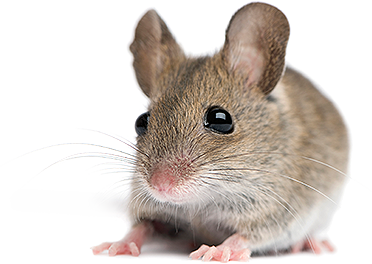Mouse education 101
Appearance
The house mouse is a small, slender rodent that has a slightly pointed nose; small, black, somewhat protruding eyes; large, sparsely haired ears; and a nearly hairless tail with obvious scale rings.
Adult house mice weigh about 2/5 to 4/5 ounce. They are generally grayish brown with a gray or buff belly.

Diet and Behavior
Although mice prefer seeds and grains, they eat many different types of foods and are considered to be “nibblers” because they sample all the different foods that may be in their environment. Foods that are particularly high in fat, protein, or sugar such as bacon, chocolate, butter, and nutmeats are typically preffered even when grain and seeds are present. House mice can also survive with little to no free water, and can obtain their water from the food they eat.
House mice have physical capabilities that enable them to gain entry to structures by gnawing, climbing, jumping, and swimming. Studies indicate that during its daily activities, a mouse normally travels an area averaging 10 to 30 feet in diameter. Mice seldom travel farther than this to obtain food or water. Because of their limited movement and feeding behavior they are much more difficult to control in some situations. By constantly exploring and learning about their environment, mice memorize the locations of pathways, obstacles, food and water, shelter, and other elements in their domain. They quickly detect new objects in their environment but do not fear them.
Reproduction
A house mouse is known for its ability to reproduce very quickly. Litters of 5 or 6 young are born 19 to 21 days after mating. Baby mice are born with their eyes closed and with no hair. They grow rapidly, and after 2 weeks they are covered with hair and their eyes and ears are open. They begin to venture out from the nest and eat solid food at 3 weeks.
Weaning soon follows, and mice are sexually mature at 6 to 10 weeks of age. They are known to breed year-round and a female may have 5 to 10 litters per year. Because of this, mouse populations can grow rapidly under good conditions, although breeding and survival of young decline significantly when population densities become high.
Signs that your house is infested
The following signs indicate a mouse infestation and should be treated immediately.
- Mouse droppings. Even if you only see a few mouse droppings, you know you have a problem. The droppings are a sure sign that mice are present even if a mouse is never spotted.
- Unexplained holes or tears in cloth, clothing, insulation, fabric and other materials. Mice use these materials to build their nests. If you notice shredded fabric or other materials, especially in dark corners and seldom used areas, chances are good that mice have taken up residence.
- Small holes in the bottom of desk drawers, kitchen cabinets and other pieces of furniture. Mice will chew their way in by making small holes, then use their new homes to build nests and breed.
- Strange scratching noises in the walls, specifically at night. Mice are naturally nocturnal, and you will rarely see them out in the daytime. If you have a mouse infestation, you may hear scratches and other strange noises as the animals move around in search of food and bedding materials.
If you find yourself dealing with what looks to be an infestation of house mice, don’t hesitate to give
ProActive Pest Management a
call at (630) 541-8101 for your fast FREE quote today!

